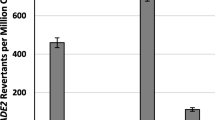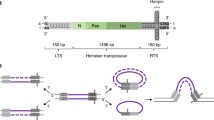Abstract
The two inverted terminal repeats (ITRs) flanking the Mos-1 mariner element differ in sequence at four positions. Gel retardation experiments indicated that each of these differences has a significant impact on the quality of the interaction between the ITR and the Mos-1 transposase. We showed that the transposase binds to the 3′ ITR better than to the 5′ ITR. The results of transposition assays performed in Escherichia coli indicated that these differences have an influence on the rate of transposition and the stability of the transposition products. Finally, we find that the wild-type configuration of the Mos-1 element, with one 5′ ITR and one 3′ ITR, is less efficient for transposition in bacteria than that of an element having two 3′ ITRs.
Similar content being viewed by others
Author information
Authors and Affiliations
Rights and permissions
About this article
Cite this article
Augé-Gouillou, C., Hamelin, MH., Demattei, MV. et al. The wild-type conformation of the Mos-1 Inverted Terminal Repeats is suboptimal for transposition in bacteria. Mol Gen Genomics 265, 51–57 (2001). https://doi.org/10.1007/s004380000385
Received:
Accepted:
Published:
Issue Date:
DOI: https://doi.org/10.1007/s004380000385




